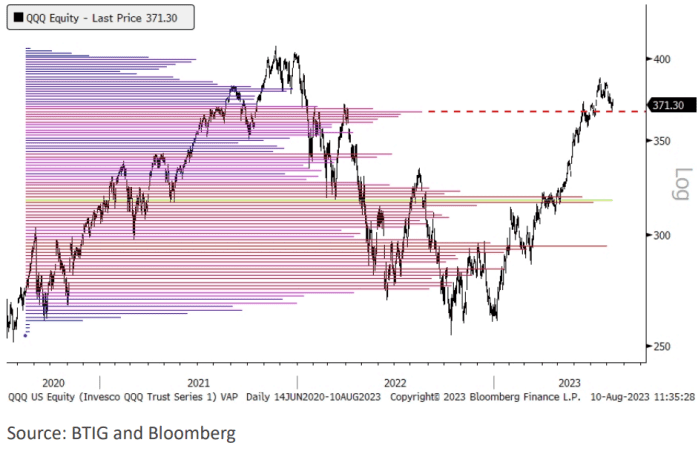The Nasdaq-100 crashed below its 50-day moving average for the first time since March this week, putting it on pace for its worst stretch of losses since December.
What’s more, the tech-heavy index is on track to cap off a two-week pullback of 4%, as of Thursday’s close. If those losses hold, it would mark the worst such stretch since Dec. 23, when the index fell 5% over two weeks, according to Dow Jones Market Data.
On Wednesday, the popular Nasdaq-100-tracking Invesco QQQ Trust Series 1 QQQ exchange traded-fund, closed below its 50-day moving average for the first time since March 10, FactSet data showed. It managed to recoup some of those losses on Thursday, rising 0.2% to $ 368.59, but remained below the moving average for a second day.
Given that the most valuable tech stocks are responsible for such a large proportion of the index’s value, their performance since mid-July is prompting analysts to worry that this late-summer pullback might morph into a bigger, and potentially broader, selloff.
Among the so-called “Magnificent Seven” stocks credited with being the biggest contributors to this year’s rally, Apple Inc. AAPL, -0.12%, Nvidia Corp. NVDA, -0.39%, Microsoft Corp. MSFT, +0.22% and Tesla Inc. TSLA, +1.30% all closed below their 50-day averages this week.
Analysts said other discouraging signs lurk under the hood. In a research note shared with clients and the media on Thursday, Jonathan Krinsky, the top technical analyst at BTIG, said that QQQ and several other popular tech-heavy ETFs are nearing a “volume pocket” that could see them move even lower, in a hurry.
An analysis of volume-at-price data over the past three years shows a sustained break below $ 368 for QQQ would leave it vulnerable to a more rapid selloff based on historical volume-at-price, a tool used by stock analysts to parse where levels of support and resistance might emerge for a given security.
Volume-at-price measures trading volume for a given security at a range of price points over a given period. Krinsky looked back at the last three years in his analysis.
“Support and resistance is based on prior price memory,” Krinsky said during a phone interview with MarketWatch. “Within that range, there is not as much price memory from participants. That is when you can get the faster price moves,” he added.

BTIG
He noted that QQQ rallied by roughly 16% over six weeks from late April to mid-June, raising the likelihood that a reversal could happen just as swiftly, if not faster. QQQ is up 38.4% year to date as of Thursday’s close, according to FactSet data.
Technology stocks have fallen in recent weeks after their latest quarterly earnings failed to impress the market.
Rising Treasury yields have helped to heap more pressure on stocks, especially the highflying technology names that are particularly sensitive to interest rates.
The big question now is whether a further unraveling of Big Tech’s advance will take the broader market down with it, or whether other corners of the market will help to pick up the slack. Together, the biggest tech stocks are responsible for roughly 40% of the valuation of the Nasdaq-100 following last month’s special rebalancing.
See: Here are 4 of the biggest changes to the Nasdaq 100 from Monday’s special rebalancing
James St. Aubin, chief investment officer at Sierra Investment Management, said it looks like traders have been content to rotate into other areas of the market that aren’t quite as richly valued as the Big Tech names.
The leaders are fading, but the laggards are coming up right behind them,” St. Aubin said during a phone interview with MarketWatch. “If money was flowing out across the board and going into cash and bonds, that would be a bit more concerning.”
U.S. stocks eked out a gain on Thursday after blowing most of their early gains. The market initially rallied after the release of July inflation data that largely matched economists’ expectations. But San Francisco Fed President Mary Daly said later that the Fed still has more work to do to tame inflation, sending Treasury yields higher and provoking a swift turnaround for equities.
The S&P 500 SPX finished barely in positive territory at 4,468, while the Nasdaq Composite COMP gained 15.97 points, or 0.1%, to 13,737.99 and the Dow Jones Industrial Average DJIA rose 52.79 points, or 0.2%, to 35,176.15, FactSet data show. The blue-chip gauge had risen more than 450 points at its highs of the session. The 10-year Treasury yield BX:TMUBMUSD10Y jumped to 4.081%, its second highest level of the year, according to Dow Jones Market Data.
